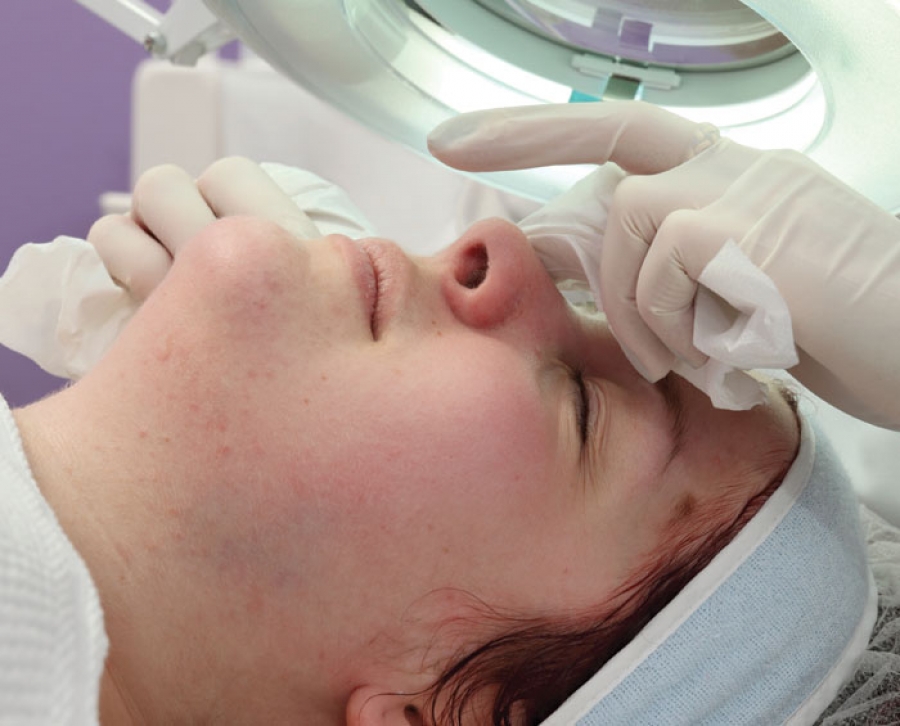Because acne breakouts are so common and the products available to treat it so prevalent, it is typical for those suffering from the condition to attempt an acne treatment regimen at home. However, without understanding the factors that cause it and the specific ingredients and steps needed to mitigate it, rarely are these self-treatment strategies successful. Rather, by employing a targeted and customized treatment strategy, aestheticians become the missing link who can take acne sufferers from frustration to relief.
Professionals certainly have the arsenal of tools needed to improve acne. Despite this, however, the condition is notoriously difficult to treat. Acne has four main direct causes, including follicular keratinization, which is abnormally “sticky” skin cells that bind together to create a glue-like substance that clogs pores rather than sloughing off properly; the production of excess sebum, the oil secreted by the sebaceous glands that lubricates the skin and makes it water-resistant; prevalence of propionibacterium acnes (P. acnes), the bacteria associated with the condition; and inflammation, which is in itself involved in the earliest stages of development of acne lesions and can also be caused by follicular keratinization or prevalence of P. acnes. Additionally, any number of environmental or lifestyle factors, diet, stress, medications, and more can trigger one of the direct causes to spring into action. What is more, acne is a genetic or hormonal condition that cannot simply be cured. Instead, the primary goal of treatment must be the optimization of skin conditions and function so the tendency to develop acne lesions is diminished. Aestheticians can tackle this task in three phases.
PHASE ONE: IDENTIFY CAUSES
Before acne can be properly treated, it is vital to identify any factors that might be contributing to the client’s condition. By utilizing an acne-oriented intake form that asks about potentially acne-inducing behaviors or scenarios, as well as thoroughly discussing with the client any lifestyle or environmental conditions present in conjunction with their acne, skin care professionals should be able to gather enough clues to identify any secondary factors that might be encouraging the development of breakouts. Among the scenarios to be on the lookout for are:
- A workplace environment that contains frequent exposure to chemicals, oil, and tar. These irritable substances can encourage follicular keratinization.
- Use of medications like contraceptives, anticonvulsants, corticosteroids, immunosuppressants, steroids, and thyroid medications. These and other medications can trigger changes in hormone levels that can cause excess sebum production.
- Frequent consumption of beer, milk, and high-glycemic foods like bread, potatoes, and most processed foods. These and other foods can trigger hormonal responses and/or cause an allergic response in the body, which leads to acne development.
- Localized friction or pressure in the area where acne is most prevalent. This can occur from cell phone use and is common in athletes and some musicians (like violinists).
- Considerable and constant stress. During times of anxiety the body produces cortisol, which can stimulate sebum production.
- The use of detergents, fabric softeners, or other topical products that may be causing an allergic reaction.
PHASE TWO: CREATE A TREATMENT PROTOCOL
The four main causes of acne can occur in any combination. Therefore, it is highly recommended that the treatment protocol thoroughly address each of them. This will require use of a multiple-step, at-home skin care regimen, as it is nearly impossible for one product to address each of these causes. Products that should be included in the at-home treatment regimen include:
- Cleanser – to remove excess skin oil, dead skin cells and bacteria that sit on the skin’s surface
- Exfoliant – to encourage the shedding of dead skin cells and unclog pores
- Clarifying Treatment – to further unclog pores, reduce sebum, and kill bacteria, and heal blemishes
- Moisturizer – one with sunscreen and formulated for acneic skin, helps skin retain its moisture levels while protecting it from ultraviolet exposure, which can exacerbate inflammation and cause further skin damage
Of primary importance is the use of well-formulated products that include high-quality ingredients in proper concentrations. Aestheticians must take care to steer clients away from skin care products or makeup that utilizes harsh ingredients like alcohol, mineral oil, or D&C red pigments, which are derived from coal tar. Examples of ingredients to look for in acne treatment products include: Retinol, glycolic acid, and/or salicylic acid to address follicular keratinization; Niacinamide, vitamin D, sulfur and/or zinc pyrithione to control sebum production; Benzoyl peroxide or tea tree oil to minimize the presence of P. acnes; Aloe vera, arnica, bisabolol, or chamomile oil to reduce inflammation.
Additionally, clients may need to make changes to the behaviors and/or situations that are contributing to their acne, if secondary causes are determined. For example, the use of protective equipment in the workplace, use of a headset instead of a cell phone, and discussions with their doctor about alternative medications.
For optimal results, of course, an at-home treatment regimen is best supplemented with regular professional treatments. Aestheticans should consider recommending facials to keep clients’ pores clear, chemical peels or microdermabrasion to address follicular keratinization, and laser therapy to kill bacteria and control sebum production.
Keep in mind that acne treatment can often make the condition worse before it gets better. It is important that clients implement the regimen consistently for at least a month before determining its success.
PHASE THREE: EVALUATE PROGRESS
Because of acne’s genetic roots, treatment must be considered a long-term commitment. (The exception is those cases where secondary factors encourage the development of the condition. Usually, by modifying these secondary conditions, acne will disappear.) Initially, it takes approximately six to 12 weeks to clear the skin. At this time, it is beneficial to evaluate the client’s progress.
It is not uncommon for acne to only slightly improve with implementation of the initial treatment regimen. In some cases, it may not improve at all. What is more, a treatment regimen might demonstrate results for a client for an extended period of time and then suddenly stop working. In these situations, it is necessary to modify the products or professional treatments being used to encourage improved results. It is also a good idea to revisit the environmental or lifestyle factors that might be contributing to acne and subsequently implement a process of elimination to zero-in on any additional secondary causes.
The latest statistics on acne reveal that the condition is growing among women who are beyond their teenage years, making it an issue of vital importance to dermatologists, plastic surgeons, and aestheticians alike. Early treatment intervention is crucial to minimize the potential for long-term side effects of the condition, which include hyperpigmentation and scarring. In those who have, however, been long suffering from the condition, aestheticians are perfectly positioned to not only help clear clients’ skin, but to also address any lingering aesthetic issues that remain after the blemishes have healed. As a byproduct of professional intervention, clients will experience unexpected benefits like a reduction in fine lines, improved skin texture, and an overall improvement in aesthetics, making acne the perfect starting point for a long-term client relationship and positive referrals.
 Dr. Ahmed Abdullah, a board-certified plastic and cosmetic surgeon, is CEO and co-founder of Lexli International, Inc. A recognized expert on the restorative and medicinal effects of aloe vera, he has authored several published studies, including “Effects of Aloe Vera on Gap Junctional Intracellular Communication and Proliferation of Human Diabetic and Non-Diabetic Skin Fibroblasts”(2003). He is a member of the International Aloe Science Council (IASC) and has served on its board of directors. Abdullah is also a clinical associate professor in plastic surgery at the University of North Dakota School of Medicine. He owns and practices at Plastic Surgery Institute PC and the Lexli Skin Care Center.
Dr. Ahmed Abdullah, a board-certified plastic and cosmetic surgeon, is CEO and co-founder of Lexli International, Inc. A recognized expert on the restorative and medicinal effects of aloe vera, he has authored several published studies, including “Effects of Aloe Vera on Gap Junctional Intracellular Communication and Proliferation of Human Diabetic and Non-Diabetic Skin Fibroblasts”(2003). He is a member of the International Aloe Science Council (IASC) and has served on its board of directors. Abdullah is also a clinical associate professor in plastic surgery at the University of North Dakota School of Medicine. He owns and practices at Plastic Surgery Institute PC and the Lexli Skin Care Center.
